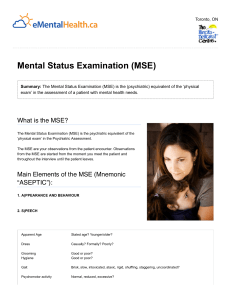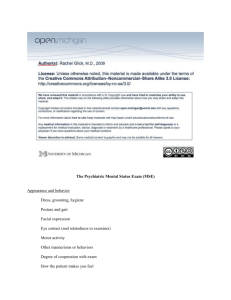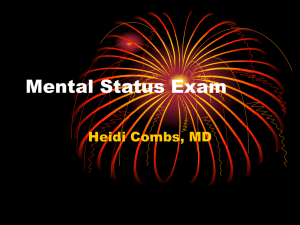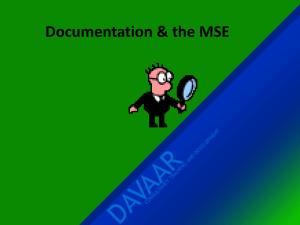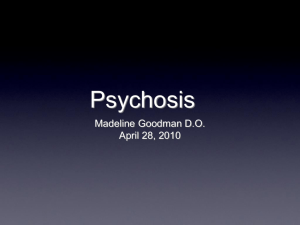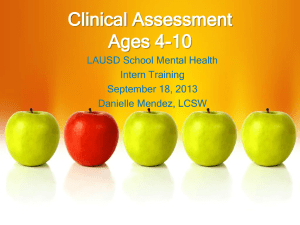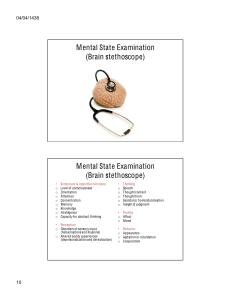The Mental Status Examination http://www.delmarlearning.com
advertisement
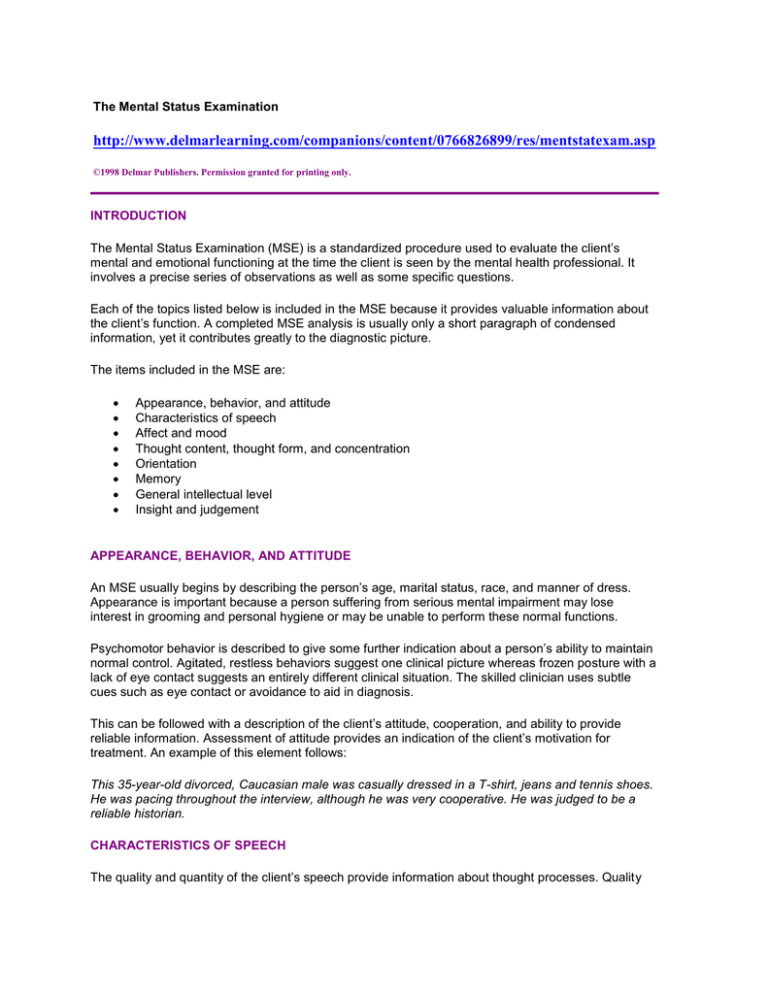
The Mental Status Examination http://www.delmarlearning.com/companions/content/0766826899/res/mentstatexam.asp ©1998 Delmar Publishers. Permission granted for printing only. INTRODUCTION The Mental Status Examination (MSE) is a standardized procedure used to evaluate the client’s mental and emotional functioning at the time the client is seen by the mental health professional. It involves a precise series of observations as well as some specific questions. Each of the topics listed below is included in the MSE because it provides valuable information about the client’s function. A completed MSE analysis is usually only a short paragraph of condensed information, yet it contributes greatly to the diagnostic picture. The items included in the MSE are: Appearance, behavior, and attitude Characteristics of speech Affect and mood Thought content, thought form, and concentration Orientation Memory General intellectual level Insight and judgement APPEARANCE, BEHAVIOR, AND ATTITUDE An MSE usually begins by describing the person’s age, marital status, race, and manner of dress. Appearance is important because a person suffering from serious mental impairment may lose interest in grooming and personal hygiene or may be unable to perform these normal functions. Psychomotor behavior is described to give some further indication about a person’s ability to maintain normal control. Agitated, restless behaviors suggest one clinical picture whereas frozen posture with a lack of eye contact suggests an entirely different clinical situation. The skilled clinician uses subtle cues such as eye contact or avoidance to aid in diagnosis. This can be followed with a description of the client’s attitude, cooperation, and ability to provide reliable information. Assessment of attitude provides an indication of the client’s motivation for treatment. An example of this element follows: This 35-year-old divorced, Caucasian male was casually dressed in a T-shirt, jeans and tennis shoes. He was pacing throughout the interview, although he was very cooperative. He was judged to be a reliable historian. CHARACTERISTICS OF SPEECH The quality and quantity of the client’s speech provide information about thought processes. Quality refers to relevance, appropriateness to topic, coherence, clarity, and voice volume. Quantity describes the amount and rate of speech, and any sense of pressure. Typically, the following items are identified, if present: Mutism, or no verbal response Circumstantiality, or excessively irrelevant detail Perseveration, or the repetition of the same words or phrases Flight of ideas or rapid, loose association of content, including: Quick topic changes Minimal or unusual connection between ideas Simple rhymes Clang associations (associations linked by sound) Puns Blocking, or a sudden interruption in thought processes that is thought to occur because an unconscious process interferes with the client’s concentration or because the client is responding to internal stimuli such as auditory or visual hallucinations An example of this element follows: Speech volume was normal; rate of speech was pressured with a tendency to focus on the negative circumstances surrounding his recent divorce. AFFECT AND MOOD Affect is the visible reaction a person displays toward events. Mood is the underlying feeling state. Affect is described by such terms as constricted, normal range, appropriate to context, flat, and shallow. Mood refers to the feeling tone and is described by such terms as anxious, depressed, dysphoric, euphoric, angry, and irritable. Important patterns to look for include: Incongruent affect, in which the client’s expression is of feelings opposite the ones appropriate for the context Lack of affect, in which emotional subjects are described in a detached manner Overreactions, in which a client may display an emotional response that is excessive in relation to the situation Examples of this element follow: Affect constricted, with mood dysphoric. Mood congruent with content. Affect irritable, hostile and labile. Mood depressed and angry. THOUGHT CONTENT, THOUGHT FORM, AND CONCENTRATION Thought Content Thought content is examined to identify whether the person is having irrational thought, thought fixations, or disturbances in thought that would suggest the presence of delusions, illusions, or hallucinations. Delusions Delusions are fixed, false beliefs that are contrary to reality. Rational evidence will not influence a person to change such a belief. Common delusions include: persecution or special attention grandeur nihilism alien control self-deprecation somatic delusions Illusions Illusions are false perceptions in response to an external object that other people can also see. For example, a person may perceive a cord lying on the floor as a coiled snake. Hallucinations Hallucinations are false sensory perceptions. Auditory or visual distortions are the most common. Thought Form The sequence of thoughts, logical connections, and the ability to provide specific information are elements of thought form. When a thought disorder exists, associations between thoughts may be disconnected, constantly changing, or blocked. The person may use vague, nonspecific terms that indicate an impoverishment of content or he or she may have difficulty with abstract ideas. Proverbs are used to evaluate this response. A person who is reasoning normally will interpret such common proverbs as "a rolling stone gathers no moss" and "people who live in glass houses shouldn’t throw stones" abstractly. A person with a thought disorder will attempt to explain the statement literally, replying, "The moss can’t stick to the stone" or "Glass breaks easily." Concentration Concentration inability is another indicator of thought disturbance. A good evaluation tool is the Serial 7 test, in which a person is asked to sequentially subtract 7 from 100. Many people with thought disorders cannot perform more than one or two calculations. ORIENTATION Orientation in terms of time, place, person, and self is assessed to determine the presence of confusion or clouding of consciousness. This is important information for determining whether the person has organic mental impairment. QUESTIONS TO ASK Can you tell me today’s date? Do you know the day of the week? What month is it? What year is it? Do you know where you are? Do you know who I am? Do you remember your name? These questions are usually asked in this sequence. With increasing impairment, the client will tend to have more difficulty with these questions. Orientation to self is usually retained with early stages of confusion or disorientation. MEMORY Both recent and remote memory are assessed. If the person has an organic brain dysfunction, memory for remote past events commonly remains intact, with loss of memory for more recent events. Any changes in memory or ability to recognize familiar surroundings or people should be cause for further investigation because it can be an early sign of a neurological problem that may respond to medical treatment. QUESTIONS TO ASK Long-term memory: Where did you live when you were growing up? What was the name of the school you went to? Short-term memory: What did you have for breakfast? What did you do yesterday? GENERAL INTELLECTUAL LEVEL The client’s basic knowledge (often called the fund of knowledge) and awareness of social events are assessed. QUESTIONS TO ASK Who is the president of the United States? Who is the vice president? Who were the last five presidents, in order? What is the state capital? INSIGHT AND JUDGEMENT Insight is the client’s ability to identify the existence of a problem and to have an understanding of its nature. This is a very important factor in assessing the client’s potential for compliance with treatment. A person will not follow treatment recommendations when he or she does not believe that problems are really there. Social judgement is also evaluated. A question commonly used is "If you were to find a stamp, addressed envelope lying on the sidewalk, what would you do? SAMPLE MENTAL STATUS EXAMINATION The client is a 33-year-old married woman who is morbidly obese. She is slightly disheveled. She is cooperative with the interviewer and is judged to be an adequate historian. Her mood and affect are depressed and anxious. She became tearful throughout the interview. Her flow of thought is coherent and her thought content reveals feelings of low self-esteem as well as auditory hallucinations that are self-demeaning. She admits to suicidal ideas but denies active plan or intent. Her orientation is good. She knows the current date, place, and person. Recent and remote memory are good. Fund of knowledge is adequate. The client shows some insight and judgment regarding her illness and need for help. Excerpted from Mabbett, P. D. (1996) Delmar’s Instant Nursing Assessment: Mental Health. Albany, NY: Delmar Publishers.
